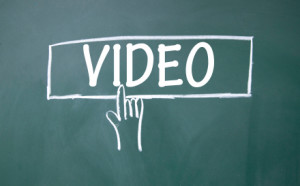by gabriel_sales | May 6, 2014
 Video, especially digital video, has grown so prevalent; it is likely to be the defining media format of our time. Over 100 hours of video now are uploaded to YouTube each minute, and it would take over 1,000 years to watch every video uploaded.
Video, especially digital video, has grown so prevalent; it is likely to be the defining media format of our time. Over 100 hours of video now are uploaded to YouTube each minute, and it would take over 1,000 years to watch every video uploaded.
Here are 3 reasons you should be using B2B video in your digital marketing programs:
1. Your buyers watch them.
While we all love our cat videos, it seems we also (at least somewhat) enjoy watching business videos and commercial advertisements. Forbes recently stated that 75% of executives watch work-related videos on business websites at least once a week. Forbes also found that 59% of executives would rather watch a video than read text.
2. They can influence your buyers’ subsequent web activity.
Many studies on B2B video engagement have found that videos are able to influence buyers to further engage with your company in some way. Forbes stated that 65% of executives visit the marketer’s website after viewing a video. Similarly, Zabisco found that 46% of people who viewed a video ad took some action after viewing it. Specifically, they found:
- 26% looked for more information about the subject of the video (Zabisco)
- 22% visited the website named in the ad (Zabisco)
- 15% visited the company represented in the video ad (Zabisco)
3. They can motivate a buying decision.
While impulsive decisions are much more likely to happen in the B2C space (where 65% of people are much more likely to buy a product after seeing a video), videos can motivate purchase decisions in the B2B space as well. Forbes Insight found that after watching a video, about 50% of executives went on to make a purchase for their business.
For more on the advantages of B2B video, read this quick blog on 3 Reasons You Should Leverage B2B Video in 2014.
Feel free to contact us with any questions.
by gabriel_sales | Apr 29, 2014
 While cold calling has never been easy, it certainly has not gotten any easier in the past few years.
While cold calling has never been easy, it certainly has not gotten any easier in the past few years.
Using the data we’ve gathered as an outsourced sales team for B2B companies, in 2013 our average call (time a rep picks up the phone) to connect (times a decision maker picks up the phone) ratio was between 7% -16% (depending on the Industry). In 2008, it was between 12% – 21%. This means that cold calling is now 30% to 50% less effective getting someone on the phone. In part, this is driven by better screening technology, but it is primarily driven by the fact that with downsizing, there are less decision makers doing more work, so they have less time to pick up the phone.
In order to help you get the most out of your cold calling, here are three tips for B2B cold calling success:
1) Know Your Target:
Spend more time researching and less time calling. Look at what your target company does and your specific prospect’s role there. Look up he or she on LinkedIn to see their past work experience, interests, anything that can give you an idea of what makes this person tick.
The more you know going into the call, the less cold the call is. This process helps to generate momentum in your favor and further ensure a successful first contact. Additionally, consider the time zone in which your prospect is located. The absolute best times to cold call are between the hours of 8-9am and 4-5pm, with the lunchtime period of 1-2 being the absolute worst.
Continue reading this blog series.
For more on how cold calling’s decline in effectiveness has changed the B2B sales and marketing process, watch this quick video. You can find out more about the value of an outsourced sales team here. Feel free to contact us with any questions.
by gabriel_sales | Apr 22, 2014
 Not too long ago, sales had a lot of power. Sales people used to be able to use knowledge and information as a closing tool.
Not too long ago, sales had a lot of power. Sales people used to be able to use knowledge and information as a closing tool.
Today, we live in a world of information, most of which is freely accessible. Buyers have no reason to go to a salesperson for information when they can go a website to get the same thing. Google’s Think Insights recently wrote:
“. . . our research has shown that, on average, business buyers do not contact suppliers directly until 57 percent of the purchase process is complete. That means for nearly two thirds of the buying process, your customers are out in the ether: Forming opinions, learning technical specifications, building requirements lists, and narrowing down their options, all on their own, with minimal influence from you.”
The main take away here is not that B2B buyers are now completing the majority of their buying process on their own, it is that they prefer to do so. If buyers preferred the old sales process, they would have continued to engage with it. Data shows they aren’t, so the question we need to ask ourselves is what do buyers like about this new process.
The main difference we see between the old and new sales model is choice. In the old model, buyers had little choice in when to be sold to—everything was done in the seller’s way and on the seller’s time. Today, the buyer can choose everything about their buying process experience: when, what, how, where. If your sales and marketing process isn’t set up to give your buyer this type of freedom of choice, he is also free to choose to leave your buying process altogether and buy from a competitor.
The buyer likes to have freedom of choice. And, the company who is able to give it to them will be the one who wins the business.
Continue reading for more on B2B sales and freedom of choice.
by gabriel_sales | Apr 10, 2014
 During the course of our sales process, we often hear from early stage prospects who have not really thought about outsourcing to help outperform the competition in terms of lead generation. Many of these early stage prospects haven’t committed to outsourced B2B lead generation and often struggle to understand or grasp the enormity of change that can occur as a result.
During the course of our sales process, we often hear from early stage prospects who have not really thought about outsourcing to help outperform the competition in terms of lead generation. Many of these early stage prospects haven’t committed to outsourced B2B lead generation and often struggle to understand or grasp the enormity of change that can occur as a result.
What many companies fail to realize is that simply by freeing up the time that was once spent educating and qualifying, you are now able to provide a deeper level of service to your customers, which in turn can lead to higher retention, more upsell possibilities and more referrals.
By shifting focus to serving the needs of your prospects, you change the dynamics of the entire conversation. The prospect realizes you are there to help, rather than to just sell.
By leveraging outsourced B2B lead generation, you have a team of experts at your side to help with all of the heavy lifting. While your competitors struggle to figure out how to get more leads or implement a marketing automation platform, you are freed to focus on strategy, content, and closing that can help you outperform the competition.
The other major benefit to B2B sales outsourcing has to do with time. Sales and marketing have changed dramatically in recent years with the rise of digital technology, and adapting your sales process to this new digital environment is a task that is neither simple nor quick.
As B2B sales and marketing outsourcers, we have over 13 years of experience building scalable sales machines, and we have developed a proven and streamlined process for running integrated sales and marketing campaigns for our clients. We have found that using this process, we can achieve in 90 days what typically takes 9-18 months for a client to implement on their own. For startup companies looking to take a new product to market, this difference can be significant when attempting to outperform the competition.
To learn more about the value of leveraging outsourced B2B lead generation to outperform the competition, read How an Outsourced Sales Team Can Help Your Marketing Team. You can learn more about the B2B outsourcing services we offer on our service page.
Please feel free to contact us with any questions.
by gabriel_sales | Apr 7, 2014
 As technology advances, marketing tactics need to adapt to how people are getting and sharing information.
As technology advances, marketing tactics need to adapt to how people are getting and sharing information.
For many years, marketing has generally been split into two categories, Business to Consumer (B2C) and Business to Business (B2B). While these were effective ways to look at marketing in a business sense, these definitions can hide the fact that in either case, you are marketing to people. As Bryan Kramer wrote for Social Media Today, we should be focused on Human to Human (H2H) sales and marketing.
What does this mean for your marketing tactics? It is time to start connecting with your potential clients in a different way. Rather than ‘selling hard’ or feature/benefit messaging, H2H simplifies our language and puts an emphasis on empathy and personalization while connecting with people socially.
Here are four ways you can make your marketing more H2H:
1. Speaking Human
More and more, people use social platforms to communicate, get information and share what they learned. This means your messages should be simplified and easy to share. It is acceptable to write in a conversational tone and avoid big words.
2. Social Sensory Marketing
In order to grab and hold the attention of prospects, you need to appeal to and connect with the basic human sensory system. The best way to do this is to incorporate imagery and video into your day to day marketing. You may get a few views on your text only post, add a picture and your numbers will likely increase. Add a cartoon or a video and you’ll up your chances of getting shared.
3. Customer Relationships
People want to connect with you and your brand. It is important to start that connection early. One way to let your potential clients get to know you is through video. When a potential client can see who they’ll be working with, it starts to build trust, which will speed up the sales process significantly. To learn more about creating headshot videos, read 5 Basic Tips for Executive Headshot Videos.
4. Become a Better Storyteller
This is your chance to appeal to people’s emotions. Tell stories about the pains your current clients were experiencing and how you were able to help them. Use pathos to connect with your potential clients and let them know you understand and can lend a helping hand. Read 3 Ways to Incorporate Storytelling into Your Marketing Content for more on how to be a better storyteller in your marketing content.
H2H marketing makes you look at what people want in everyday life and how they want to feel. So what is it that people want? They want to be a part of something bigger; they want to feel, to be included and to understand. We are no longer just selling a product or service we are connecting with people.
To learn more about how to appeal to your customers, read What Do B2B Customers Want from your Branding and Marketing Content?
Feel free to contact us.
by gabriel_sales | Apr 4, 2014
 Cold callers on their own are no magic bullet for marketing success
Cold callers on their own are no magic bullet for marketing success
This is part two of a blog series. Read part one here.
At its most basic, we believe this approach has been successful because today, buyers don’t like to be sold products; they like to buy solutions that solve their problems. Our integrated approach simply makes this easier.
Sales reps supported with strong and authentic content enable buyers to educate themselves and buy on their own terms and on their own time line. The sales professional now adds value to the buyer’s day as opposed to being another disruptive interruption (such as cold callers). Because once a prospect feels educated on a product or service, the sales pitch is no longer intimidating or overwhelming. It is providing value and helping them to reach a decision.
For example, you may want to buy a guitar amplifier but know little about electronics. A salesman going on and on about transistors and capacitors and signal conversion is not going to get you any closer to making an informed decision. However, reading a brochure titled, “5 Things to Look For When Choosing a Guitar Amplifier,” may help you (the buyer) understand what capacitors and signal conversion acutally are. You then feel more educated and can evaluate the pros and cons of the capacitors and their impact on the type of music you want to offer as your service to the world. Then, you and the salesman can have an intelligent dialogue around guitar amplifiers and you can leave feeling truly satisfied with your purchase decision.
Knowledge is no longer a tool for the salesperson. Knowledge is a tool to create wins for both the buyer and the company.
By offering valuable, educational content to early stage prospects that does not try to sell anything, prospects are able to engage with your company in a nonthreatening way. This digital engagement helps to slowly build trust, so when your prospect has a real need and real budget, they are willing to take a call from a sales rep, and no one feels that the call is ‘cold’.
Getting to this point in your sales and marketing process takes some time and requires a fair amount of patience. But after a year to 18-month commitment to the approach, your whole sales process changes for the better. Your cost of sales percentage decreases, your margins increase, and your deal flow accelerates exponentially.
Rather than searching through thousands of people at a multitude of different companies to try to find those in need of help, you can look at a dashboard, see who is interested and have specific topics to talk to them about.
If you would like to learn more about how sales and marketing have changed or our integrated sales and marketing process, read, “The Shift to Bought then Sold”. If you would like to learn more about our integrated sales and marketing outsourcing services, you can visit our services page.
Feel free to contact us with any questions.
 Video, especially digital video, has grown so prevalent; it is likely to be the defining media format of our time. Over 100 hours of video now are uploaded to YouTube each minute, and it would take over 1,000 years to watch every video uploaded.
Video, especially digital video, has grown so prevalent; it is likely to be the defining media format of our time. Over 100 hours of video now are uploaded to YouTube each minute, and it would take over 1,000 years to watch every video uploaded.





